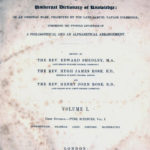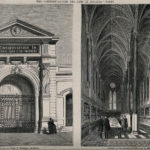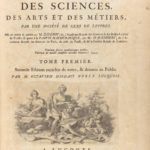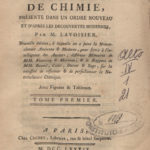Festschrift: At the Boundary between Science and Industrial Practices: Applied Science, Arts, and Technique in France
Abstract
https://dx.doi.org/10.15180/201309/001In response to Robert Bud’s historical inquiry of applied science, this paper discusses whether it has been adopted in France. I argue that although the term was occasionally used in France it has never been successful because of the prestige of arts in the encyclopaedic movement.
Keywords
Arts, Encyclopédie, Industrial science, technique, technonomy
Introduction
https://dx.doi.org/10.15180/Robert Bud’s longstanding historical investigation of the concept of applied science in various national contexts leads me to venture some reflections about the French case. Bud demonstrated that the notion of applied science emerged in English language in the Encyclopedia Metropolitana (see Figure 1), edited by Samuel Taylor Coleridge in 1817, and had been embodied in the creation of a number of colleges in Britain throughout the nineteenth century. It became socially and politically important in 1870s Britain (Bud and Roberts, 1984; Bud, 2012). It struck me that the phrase ‘applied science’ never really gained such traction in France. Hence my question: Was it in competition with cognate and more established concepts?
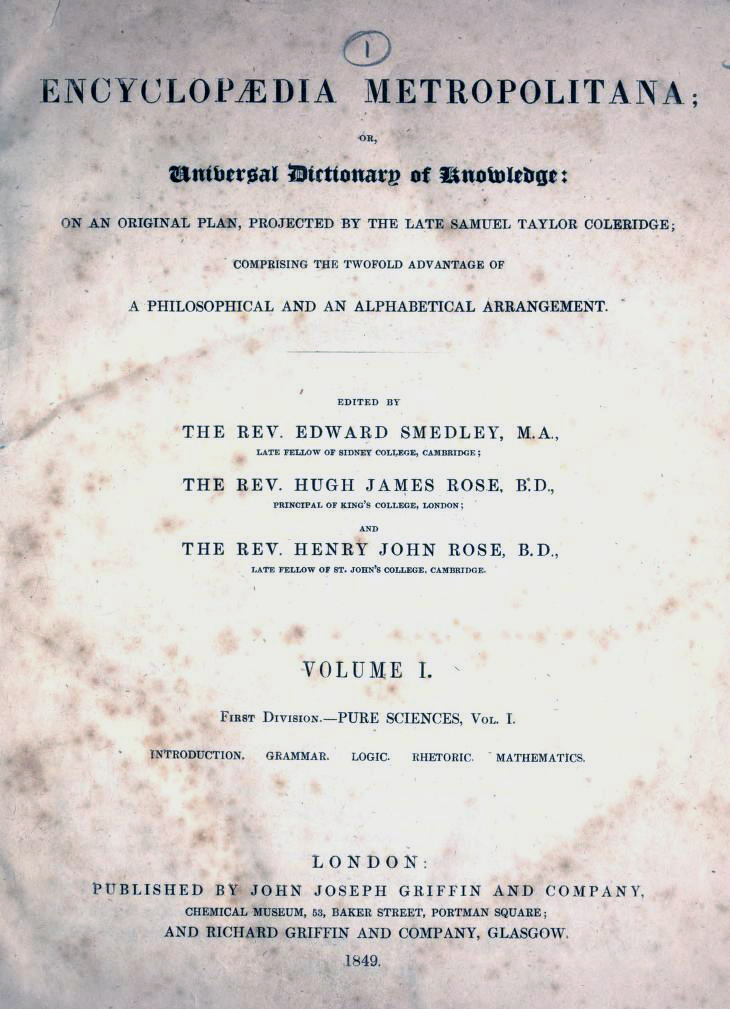
My reflections on the French case do not proceed from a dedicated systematic research programme like Robert Bud’s on the idea of applied science or Ruth Oldenziel’s (1999), Eric Chatzberg’s (2006) and Leo Marx’s (2010) extensive research on the history of the term ‘technology’ in national contexts. As I am just capitalising on my experience as a historian and philosopher of science and technology (Bensaude-Vincent, 2008; Loeve et al, 2018), these reflections are to be read as simple footnotes to the works mentioned above.
I fully agree with Bud on the national component of the idea of applied science although it retains a transnational dimension linked to the transformation of scientific knowledge in the industrial world. Educational institutions meant to act as mediators between science and industrial practices by training industrial entrepreneurs and workers similar to those in the United Kingdom have been founded in France, although they did not help promote the idea of applied science. The idea of arts prevailed in the creation of the Conservatoire des arts et métiers in 1794, and of the Ecole centrale des arts et manufactures founded in 1829. It gradually gave way to the prevailing idea of industrial research in the late nineteenth century as instantiated by the Ecole municipale de physique et de chimie industrielles de la ville de Paris, which opened up in 1882. If the notion of applied science connotes modernity, and progressive thinking, as Bud convincingly argues, does it mean that we (French people) ‘have never been modern’? Or that we became modern only at the dawn of the post-modern world since it was only in the 1950s that the phrase ‘applied science’ gained currency when a group of engineering schools named Institut national de sciences appliquées were created.
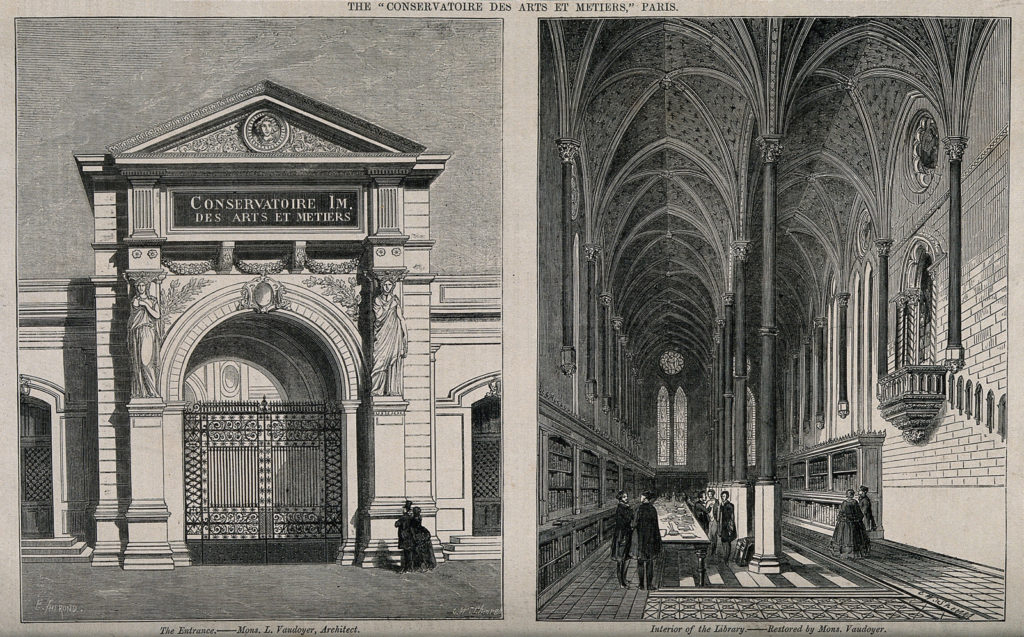
Desperately looking for a candidate alternative to the British concept of applied science, I realised that in France, the concept of applied science was occasionally used but never stabilised. Interestingly the French Académie des Technologies was founded in the early 2000s by scission of a section of the Academy of Science named Council of Applications (Conseil des applications de l’Académie des sciences). In rejecting the term ‘applications’ it clearly aims at the promotion of technology as distinct from science. Over the past two centuries the terrain between science and industrial practice has been covered by a cloud of cognate concepts such as arts, industrial arts, and industrial science. The main result being that the shift from les arts to la technique is relatively recent, since a general conception of la technique was missing until the 1930s.
Local pre-modern sources
https://dx.doi.org/10.15180/201309/002Let me first mention that in medieval universities what we consider today as sciences belonged to the category of arts. The term Scientia was reserved for subjects searching for the ultimate causes – physics, metaphysics and theology. Seven liberal arts were taught. For the master’s degree in arts the student had to go through the trivium – grammar, logic and rhetoric – and then the quadrivium – arithmetic, geometry, music theory and astronomy. The Mechanical arts were not taught at university but medical faculties opened up in a number of European cities in the twelfth century.
The conventional dichotomy between theory and practice often subdivided the contents of arts. For instance a Dictionnaire mathématique published in Amsterdam by Jacques Ozanam distinguished the speculative or theoretical part focused on the knowledge of something from the practical part teaching how to operate with it. Similarly the introduction of chemical arts in medical faculties in the seventeenth century prompted the distinction between theoretical and practical chemistry. Pierre Joseph Macquer, who published Elémens the chimie théorique in 1749 followed by Elémens the chimie pratique in 1751, claimed that the former could be presented according to a systematic logical order (from simple to complex), while the latter had to detail the procedures of chemical operations.
While science/arts, and theory/practice remained generic categories used for mapping knowledge, the divide between pure and applied emerged locally for distinguishing two distinct perspectives on a particular subject. The divide between pure and applied has been traced back to Johannes Wallis’s Mathesis universalis (1657). He contrasted mathematica pura dealing with quantity in an absolute or abstract sense and mathematica mixta where quantities were attached to something. Later Christian Wolff distinguished mathesis impure sive mixta from mathesis pura sive simplex (Meinel, 1983:131). Ironically it is a chemist who replaced the term ‘mixt’, taken from the language of chemistry, by the term ‘applied’. In 1751, Johann Gottshalk Wallerius, a lecturer at Uppsala University, introduced the distinction between chemia pura and chemia applicata in a dissertation De nexu chemiae cum utilitate reipublicae (On the connections of chemistry with utility of the republic). He clearly stated that the old divides between science and art, and theory and practice, were obsolete since applied chemistry could be presented as a practising science (Meinel, 1983: 126–127). His textbook distinguished nine branches in applied chemistry, which covered most chemical arts: medical chemistry, stone chemistry, metal chemistry, fire chemistry, salt chemistry, glass chemistry, economic chemistry, colour chemistry and crafts chemistry. The conceptual dichotomy between pure and applied chemistry astutely turned the chronological antecedence of chemical arts over chemical knowledge into a logical relation of dependence of arts upon science, a dependence of chemical practice upon a core-theory that Wallerius considered as the foundation of applied chemistry. At about the same time in France, in Macquer’s textbooks, although the volume about practice was published after the volume about theory, the practical chemistry was by no means subordinated to theory, nor was it of less importance. Theory and practice were on an equal footing.[1] By contrast, the dichotomy between pure and applied science suggested a relation of dependence. It seems that the divide pure/applied chemistry was part of the chemists’ struggle for status. It actually provided a key argument for the promotion of chemistry as a science on the academic stage.
The notion of pure science or andgewandte Wissenschaft spread in Scandinavia and Germany through translations of Wallerius’s treatise where it apparently benefitted from a collusion or confusion[2] with Kant’s notion of pure knowledge (Bud, 2012). Whatever the fluctuations of the exact meaning of the adjectives ‘pure’ and ‘applied’, this dichotomy undoubtedly created a continuity between two varieties of science which overcame the difference of nature implicit in the conventional dichotomy between science and art. In a long-term perspective, the invention of the divide between pure and applied science appears as a symptom of the increasing valuation of science and its primacy over arts in European society. In this respect it is often presented as a marker of modernity, characterised by the primacy of science over technology (Forman, 2007).
The 'artiste' as hero of French Enlightenment
https://dx.doi.org/10.15180/201309/003While the idea of applied science gained traction in the German world, in France the Encyclopédie des sciences des arts et des métiers celebrated arts and crafts in the public sphere.

In contrast to Wallerius’s view of arts as applied science, Diderot’s notion of arts included knowledge as well as practices. In the entry ‘Art’ he claimed that all arts have theoretical and practical aspects, which were complementary.
It is difficult if not impossible to go far in the practice of an art without speculation, and, conversely, to have a thorough knowledge of the speculative aspects of an art without being versed in its practice. In every art there are many particulars concerning its material, its instruments, and its application which can only be learned through practice. It is the function of practice to present difficulties and phenomena, while speculation must explain the phenomena and solve the difficulties. Consequently, only an artist who can think logically can talk well about his art.
Diderot’s collaborator Gabriel-François Venel, in charge of the entry ‘Chemistry’, celebrated the heroic figure of the artiste as a learned artisan. He distinguished him from both speculative philosophers and craftsmen locked in their blind routines. Far from considering chemical arts as mere applications of a ‘pure chemistry’, Venel claimed that a true chemist is first and foremost an artiste. The artiste has a true knowledge acquired through manual work in the laboratory. It includes not only a collection of know-how for glassblowing, luting, repairing and adapting vessels but also an intimate acquaintance with the behaviour of chemical substances acquired through a long experience of laboratory work. The artist’s knowledge is much more than rules-of-thumb, it is a real tacit knowledge requiring the full engagement of the body and the mind together. Venel’s portrait of the chemist-artist instantiates Diderot’s ideal of experimental philosophers who enjoy a hybrid social status between the ‘philosophers who only have ideas’ and the operators (maneuvres) who endlessly move around with no specific cognitive purpose (Diderot, 1753). Thus the French encyclopaedic movement promoted the arts as integral parts of natural philosophy. Arts contributed to the advancement of knowledge as well as to the public good or welfare. Diderot’s defence of arts had a political dimension. He protested against the low social status of artisans and deplored that the traditional distinction between mechanical and liberal arts had contributed to the discredit of manual workers who are confronted with daily difficulties requiring patience and skills. In a similar vein Venel praised chemistry for it ‘contains within itself two different languages, one popular and the other scientific’ (Venel, 1753).
Arts, a resilient category
https://dx.doi.org/10.15180/201309/004The social prestige of the category of ‘arts’ characteristic of the Encyclopaedist movement was not altered by the chemical revolution and the concomitant French revolution. Although Lavoisier was more concerned with the reform of the theoretical foundations of chemistry, he never envisaged turning chemical arts into branches of applied chemistry. Quite the contrary. In the context of the French revolution he wrote some Reflections on Public Instruction (Lavoisier, 1793) with the sketch of a course of chemical arts. He followed the model of mechanical arts rather than recommending to begin with his Traité élémentaire de chimie (see Figure 4). Following a brief survey of the simple substances used in chemical arts, the course would proceed to a classification of chemical operations similar to the classification of machines.
Le cours relatif aux arts chimiques devra commencer par une exposition des corps naturels qui sont en usage dans les arts, par une description de leurs qualités extérieures, par quelques explications sur leur origine. Passant ensuite à l’emploi de ces substances simples, le professeur fera voir que les opérations chimiques relatives aux arts peuvent se classer, se décomposer comme les machines ; que ces opérations se rapportent à des combustions, à des décombustions, à des dissolutions, à des cristallisations, à des précipitations, à des fermentations. Il aura comme dans le cours des arts mécaniques, l’attention de commencer par les généralités qui sont communes à un grand nombre d’arts, et de réserver pour la fin de son cours les instructions relatives aux arts qui exigent des développements particuliers.
Lavoisier’s views about chemical arts strikingly differed from Wallerius’s applied chemistry. His sketch was kin to Johannes Beckmann views of ‘Technologie’ – the discourse or science about die Technik – developed during the same period. Like Beckman, Lavoisier insisted that the taxonomy of operations – rather than scientific principles – were the crucial condition for improving arts.

In a similar vein, the French chemists who during the revolutionary wars used their knowledge and teaching capacities to provide saltpetre or cannons and ‘save the homeland’, did not promote the distinction between pure and applied chemistry in the aftermath of the Revolution when the reform of teaching institutions offered a unique opportunity of designing radically new curricula. Although Antoine de Fourcroy was able to impose a chemical turn in the curriculum of the Ecole de pharmacie, he did not present pharmacy as a branch of applied chemistry, for that matter. Jonathan Simon (2005) argued convincingly that a kind of tacit division of labour was established after the chemical revolution between chemistry, focused on inorganic substances, and pharmacy, engaged in the study of plants.
Even when the phrase ‘pure and applied science’ has been used by a number of French authors and publishers in the booming industry of textbooks or scientific journals of the nineteenth century, it did not convey a dependence of applications. Jean-Antoine Chaptal, an academic chemist and entrepreneur, who became Minister of Interior under the Consulate and founder of the Society for Encouraging National Industry (Société d’encouragement de l’industrie nationale), used the phrase ‘applied chemistry’ in the title of a multivolume textbook Chimie appliquée aux arts. However, his textbook did not follow Wallerius’s model of applied chemistry. Although in the preliminary discourse Chaptal enthusiastically celebrated chemistry as the central science, ‘an inexhaustible source of novel arts’, he immediately emphasised that this science could not meet the needs of industry. He rather attempted to describe chemistry from the standpoint of manufacturers. He explicitly recommended them never to apply the knowledge produced in laboratories in their manufactures because laboratory chemists ignore the multiple constraints of industrial production ranging from the availability of raw materials, market, manpower …
Le fabricant pourrait aisément compromettre sa fortune et sa réputation s’il réglait sa conduite, ou fondait ses spéculations, sur quelques résultats de laboratoire ou sur des apparences trompeuses. Ce n’est qu’avec la plus grande circonspection qu’on doit porter dans les ateliers les innovations, quelqu’avantageuses qu’elles paraissent.
Far from stressing the continuity of chemical science and industrial practice Chaptal insisted on the gap between them. He pointed out that scaling up changes the process. Chaptal was no exception; he shared this emphasis on the distance between arts and science with Charles Dupin and other directors of the Conservatoire des arts et métiers.
'Technonomie' a French alternative to applied science?
https://dx.doi.org/10.15180/201309/005One of them, Gérard-Joseph Christian, the director of the Conservatoire between 1816–1831, ventured an alternative to the notion of applied science promoted by Coleridge in Britain in the same period (Picon, 1994; Day, 1987). His Plan de technonomie, published in 1819, clearly occupies the same terrain between science and industrial practices as Coleridge’s applied science. It testifies to the persistent encyclopaedists’ valuation of arts. When the Society for the Encouragement of National Industry reviewed Beckmann’s fifth edition Anleitung zur Technologie in its Bulletin (Mertens, 2010), this legacy merged with the strong influence of German Technologie viewed as the ‘science of industrial arts’ (Lenormand, 1819) in the French industrial age.
Christian traced the genealogy of his technonomie through the successive attempts to fill the gap between science and arts. The first attempt that he mentioned was the Encyclopédie, which provided a comprehensive description of arts and crafts. The second step, Beckman’s Technologie responded to the needs of industrialisation and public administration with a classification of arts and operations. Technonomie, Christian went on, is meant to overcome the weakness and arbitrariness of the treatises of Technologie which failed to shed a ‘common light’ on the variety of arts (Christian, 1819: 35). Far from being presented as an applied science, technonomy was conceived as a basic science. It was not just comprehensive (embracing all kinds of works). It was also explanatory as it attempted to ‘uncover the foundations of the general system of production and the principles of which all modes of work are but various applications’ (Ibid: 37). Christian chose ‘technical operation’ as the central unifying concept allowing a taxonomy of all productive activities. He insisted that machine designers should not imitate the manual operations that they want to mechanise. Christian’s objective was to formulate the general principles governing all kinds of works – in agriculture, industrial labour and commerce – with a view to optimising industrial production from an economic standpoint. Therefore technonomy was a multidisciplinary science embracing ‘natural sciences, industrial practices, aesthetics and high economic administration’ (Ibid, p 38). It hybridized nature and society, the study of mechanical and chemical agencies depending on natural laws with observations of the changing taste of consumers and more generally an emphasis on the importance of circumstances.
Technonomie, in contrast to German Technologie was explicitly normative. It was meant to provide guidelines to industrial entrepreneurs in their choice of localities for their manufactures, of raw materials, of production process, as well as in the management of workers and business, with a touch of grandiose moral ambition:
La grande tendance de la technonomie est le perfectionnement général du travail ; et ce point est d’une très haute importance, car le perfectionnement du travail conduit à l’aisance générale, et l’aisance générale est le fonds dans lequel germent les bonnes mœurs, l’ordre public et l’amour de la patrie.
(Ibid, 38)
This pompous rhetoric went hand in hand with a more concrete plea for the mechanisation of work. In a context of tensions raised by the progress of the Luddites’ protests against machines in French textile manufactures, Christian openly supported the substitution of machines for workers and claimed that it was for the benefit of all actors of the system.
Thus technonomie appears as an alternative candidate for colonising the terrain between speculative science and industrial practice in nineteenth-century France. It differs from applied science by its ambition of being fundamental, comprehensive, multidisciplinary and prescriptive. This ambitious essay had a major influence among French engineering schools, such as the Ecole des mines, the Ecole des Ponts et chaussées and the Ecole centrale des arts et manufactures created in 1830.
Industrial science
https://dx.doi.org/10.15180/201309/006The rising engineering profession in France was satisfied with coining the phrase ‘industrial science’. It emerged in the provinces rather than in the Parisian circle of engineers (Grelon, 1980; Shinn, 1981). The Société industrielle de Mulhouse founded in 1826 to help build industrial practices on a firm scientific ground and encourage entrepreneurship served as a model for the organisation of science and technology in late nineteenth-century France (Fox, 1984). Following the Prussian-French war in 1870 and the subsequent loss of Mulhouse, the Alsatian model inspired the foundation of the Ecole municipale de physique et de chimie de Paris in 1882 and the creation of a laboratory of industrial chemistry at the Paris University in 1886. Industrial science differed from applied science because it was supposed to be a specific kind of scientific knowledge generated in response to industrial challenges.
Henry Le Chatelier was the champion of industrial science following his work on a law of equilibrium in chemical reactions that he applied to a variety of industrial processes such as those related to metallic alloys, the equilibrium between iron and carbon in blast furnaces, and the direct synthesis of ammonia from hydrogen and nitrogen. His aim was to increase the yield of chemical reactions, and to optimise the efficiency of industrial processes. He criticised conventional courses and textbooks in applied chemistry for providing only an abstract view of industrial processes, and ignoring the complex interactions between reagents, and failing to go into the details of the processes. For instance, textbooks often did not mention the fact that machines are greased with animal and vegetable matter that is decomposed at high temperature, with undesired consequences (Le Chatelier, 1888). As president of the Société d’Encouragement de l’Industrie Nationale (SEIN) in the 1890s, he fought against the system of prizes awarded to individual successful inventors; in his view, individual and brilliant inventions do not demonstrate the efficiency of science but, on the contrary, witness the imperfection of the current organisation of research. As he stated in his Cours de chimie industrielle à l’Ecole nationale supérieure des mines given in 1903: ‘It is indispensable to know how to measure all interconnected magnitudes. In such a way that the sine qua non condition for the application of scientific methods to industrial problems is to introduce a constant use of measurement of all phenomena that occur in the factory’ (quoted in Letté, 2004, p 175, my translation). Le Chatelier urged the creation of a research service in charge of collecting quantitative data on physical constants and coefficients, to be assembled in tables, which would become reference points to standardise industrial production. He advocated a rational organisation of scientific endeavour, with the control, standardisation, and optimisation of all processes, in order to bring a continuous and uninterrupted yield of results (Letté, 2004). His vision encouraged the creation of research laboratories within the factories, and the introduction of the hierarchical division of labour. The laboratory, being in charge of the rational organisation, was the decision maker, while the factory itself had to execute its orders. Industrial research should be privately funded, but conducted in public institutions such as the Ecole des Mines, by engineers trained in the Grandes Ecoles in order to be kept under public control. In 1904, Le Chatelier created the Revue de métallurgie, a technical magazine that aimed at encouraging entrepreneurs to move beyond their private interests, and fund projects for technological innovation. His model in thinking about science was Frederick Winslow Taylor, with whom he had started corresponding in 1906, and whom he had occasionally met. Le Chatelier actively promoted Taylor’s system in Europe with the publication, in 1928, of his book Le taylorisme, which on account of an incomplete understanding on Le Chatelier’s part, spread a rather idealised view of Taylorism as a scientific, hence a perfect, organisation of labour.
In La science et l’industrie, Le Chatelier (1925) presented a grandiose programme for creating a proportionate relation between the cost of research laboratories and the expected profits resulting from the introduction of innovations in the industrial processes. Already following Taylor, he advocated a rigid division of labour, hoping that this would bring about a continuous advancement of knowledge, instead of a few spectacular breakthroughs. Le Chatelier’s major claim was that good science grows out of industrial projects (illustrated with historical cases such as those of Lavoisier, Carnot, Sainte-Claire-Deville, and Pasteur). In line with a strict positivistic tradition he defined science as the study of natural laws, i.e. of the necessary relations that hold between phenomena, whatever their nature. But he assumed that like natural phenomena, industrial phenomena are ruled by general laws, which link the relevant parameters of the fabrication process to the quality and cost of the final product. Thus science and industry converged: science was basically a method for the collection of data acquired through careful measurements, and for the optimisation of industrial process to maximise yields. Scientific method was a means to increase the efficiency of industrial production, and of scientific research.
However, this model of industry has been rejected by the Society for Encouraging National Industry and later on by the organising committee in charge of the International Exhibition of Arts and Industry held in Paris in 1937. The Committee selected Jean Perrin’s project of an exhibit (the Palais de la découverte) celebrating pure science rather than Le Chatelier’s project of a palace celebrating the benefits of industrial science (Ory, 1991; Bergeron and Bigg, 2015).
'La technique', a recent notion
https://dx.doi.org/10.15180/201309/007Le Chatelier’s radical programme of rapprochement between science and industry occupied the space of a linguistic lacuna. In the French language there was no equivalent of the German concept Die Technik, which had inspired the concept of Technologie and Technonomie. The French noun ‘la technique’ is of relatively recent origin. Until the 1930s it was mainly used as an adjective – for instance les détails techniques (technical detail), or as a noun calling for a complement – for instance la technique de la maçonnerie (the technique of masonry). In the latter case technique referred to the methods and procedures used in the art of masonry and had nothing to do with the Greek technè that was the root of the German term ‘Die Technik’. In nineteenth-century France, the term ‘arts’ prevailed, whilst in Germany die Technik ‘became central for the self-understanding of the rising German engineering profession’ (Schatzberg, 2006: 494). In this period, there was no term available in the French language to discuss the cultural meaning of the industrial arts as a whole. Significantly, Henri Bergson never used the noun ‘la technique’ in Creative Evolution (1907). In this famous book, he claimed that productive skills are what made us humans, that homo sapiens derived from homo faber. He criticised the intellectual bias of the primacy of science over practical arts. Describing what we consider as technological activities he used a variety of terms like ‘artificial’, ‘constructions’, ‘industry’, ‘instruments’, ‘inventions’, ‘fabrication’, ‘functional’, ‘machine’, ‘manipulation’, ‘manufacture’, ‘mechanisms’, or ‘tools’. He advocated the philosophical dignity of technology without using the term. Alfred Espinas, a French sociologist who acknowledged Auguste Comte’s and Herbert Spencer’s influence was the first one who deplored the lack of a term to denote practical arts, in 1897.
We could give to the useful arts the name of ‘techniques’ so as to distinguish them from the arts meant to produce aesthetic emotion. This word of ‘technique’ has unfortunately a rather restricted meaning among us. We say the technique of education, the technique of such or such fabrication, and we so designate the operating processes or, in general, the special parts of the industrial arts […] [i.e. the methods of fabrication] rather than these arts themselves; we shall have the greatest difficulties to say les techniques instead of the ‘useful arts’, especially if […] the groups of superior rules […] such as politics and morality, must be counted among the arts and thus become techniques. There would be nevertheless some advantage in being able to designate so, as the Greeks did, the conscious and thoughtful practices that are to a certain point in opposition to the simple practices or customs that establish themselves spontaneously before any analysis.
(Espinas, 1897: 7–8), my translation
Returning to the ancient Greek roots of technê, Espinas created a distance between technology and modern life or progressive thinking. In his volume The Origins of Technology he defined technology (in the sense of a discourse on practical arts), as a science which is to the domain of action the equivalent of logic to the domain of knowledge (Espinas 1897:9). He gave a detailed historical account of technê in Ancient Greece, its connection with religion, philosophy and society. His technology is more a philosophy of action, a praxeology, than a technology in the German sense.
Marcel Mauss, a sociologist and ethnologist who campaigned for introducing la technique as a section in the journal L’année sociologique considered technology as a ‘social fact’. He developed a cultural definition of la technique as ‘traditional efficient acts’, which referred to all sorts of activities such as magic, crafts as well as industrial arts (Mauss, 1948; Schlanger, 2012). Technology as the science dealing with techniques from a cultural standpoint included: i) the description and classification of tools, instruments and machines, as Beckman’s Technologie; ii) the study of the social functions of techniques and their impact on the organisation of society; iii) comparative studies of cultures and societies. This new approach to technology has been greatly reinforced by the work of paleoanthropologist André Leroi-Gourhan, who demonstrated that technology has been constitutive of the human condition in Gesture and Speech (1964–1965).
In addition to anthropologists and ethnologists, historians developed an interest in the study of techniques as a cultural phenomenon. Marc Bloch and Lucien Febvre, the founders of the journal Annales d’histoire, dedicated a special issue to ‘Technology, History and Life’.
As a result in France ‘la technique’ is a notion close to the Encyclopédie’s notion of arts and crafts (arts et métiers)[3], and totally divorced from modern technologies with their aura of progress. Such is the divorce that engineering schools, societies and journals are not concerned with ‘la technique’ and rather use the term ‘technologie’ in its contemporary meaning in English language, denoting the object and not a research field. In common parlance, the contrast between ‘technique’ and ‘technologie’ immediately brings to mind the contrast between handicrafts or manufactures and high-tech innovations.
Conclusion
https://dx.doi.org/10.15180/201309/012In conclusion, my quest for a French term equivalent to ‘applied science’ in Britain failed. This too brief survey of the linguistic repertoire suggests that there is no obvious proper linguistic resource to cover the domain between science as a cognitive endeavour and technological practices. The encyclopaedic movement of the Enlightenment so much imprinted French culture that the highly praised notion of arts prevailed for more than a century. The entrepreneurial elite of the nineteenth century who promoted industrial arts and sciences never obliterated the strong attachment to handicrafts. Techniques enjoy a social and cultural prestige as productive practices, which shape the human condition, independently from the advancement of knowledge. In this perspective the domain between science and industry does not appear as a strategic place to colonise.


